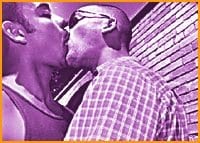Kissing is the latest forbidden activity for gay men.
And yet the simple kiss means so much – even between the species. “The philosopher Plato used to say that bees sat on his lips because his words were so true, that he was speaking honey,” says Bruce Meyer, an expert on the lip-lock and the director of writing and literature at the University Of Toronto’s School Of Continuing Studies.
Last November, scientists reported that an AIDS-related skin cancer is spread by kissing.
The virus that causes the kaposi’s sarcoma can be found in your mouth – and “deep kissing” could spread it, although the researchers said that more study is needed.
Then came meningitis. Two gay men died in May, then three others came down with a particularly nasty strain in May and June.
A press officer at Toronto Public Health announced that sharing saliva (which carries the bug) is a bad idea. Asked if this meant that gay men shouldn’t kiss, she clammed up and forwarded the message directly to the top dog.
Toronto’s chief medical officer of health, Dr Sheela Basrur, admitted that telling gay men to stop kissing isn’t helpful. “I’m well aware of the difficulty of putting out a message and making it credible.”
So at a Jul 16 press conference sponsored by Toronto Public Health, a gay man said it.
The Hassle Free Clinic’s Robert Trow read from a prepared statement: “Avoiding deep kissing is an obvious recommendation in casual or multiple sex situations.”
And then Trow added: “However, it will certainly take some of the excitement and romance out of foreplay, and will be especially difficult for men in relationships who also have outside partners. Furthermore, it will be difficult to draw a line between a casual kiss on the lips and avoiding contact with saliva. For some men, it will seem like intimacy itself is now risky in sexual relationships.”
The ancient Roman poet Cattalos makes the first serious reference to the sensual kiss in literature, according to Meyer. The bohemian writer was considered quite scandalous.
“He wrote the famous poem to his lover, Lesbia: give me a kiss, give me thousand kisses, give me a thousand kisses more….”
“It’s very sensuous,” says Meyer. “Before that people didn’t exchange bodily fluids in literature. There was porn,” but sexy kissing wasn’t a feature.
The next biggie is in the Bible – the Judas kiss, which is how Christ is marked for death. “You always crucify the one you love. It becomes identified with betrayal,” says Meyer.
(Interestingly, one kisses the pope’s ring upon meeting him. And the Catholic Church’s kiss of peace has congregants turn to their neighbours and kiss them in greeting. And then there’s the Christian kiss of life, where God breathed into the dust to create Adam, the first man.)
The next big kiss era is Shakespeare’s. The romantic tragedy Romeo And Juliet features smooching. When Hamlet dies, Horatio kisses him.
In Midsummer Night’s Dream, two lovers kiss through a hole in the wall that separates them – a theme, says Meyer, that recurs in literature. There are many stories of lovers’ kisses through barbed wire in concentration camps.
Then the smooch fell out of favour.
“Kissing was revived erotically in the 19th century, people like Rodin [with his sculpture The Kiss] made kissing popular again. It falls out of favour if you look at western art, it was something you did clandestinely or in private.
“There’s much more of a sense that you can celebrate the sensuality of the individual.”
So it’s sensual, dangerous, holy and – imparts wisdom. That’s the origin of the habit of sticking a pencil into the mouth before writing.
“The old Celtic idea was that the mouth was the source of the word, you were using the pen as shovel, actually transferring the words onto the page.”
Meyer notes that the late Diana, Princess Of Wales, told the heterosexual world that you could kiss and hug people with AIDS, and helped changed the way PWAs are seen.

 Why you can trust Xtra
Why you can trust Xtra


